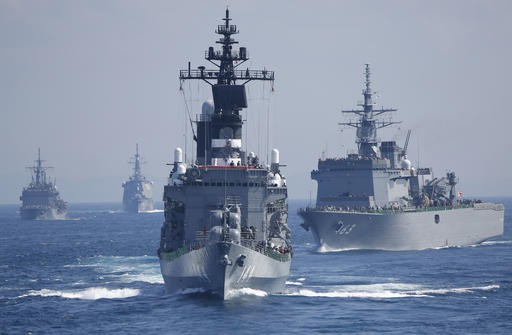Popular Reads
Top Results
Can't find what you're looking for?
View all search resultsPopular Reads
Top Results
Can't find what you're looking for?
View all search resultsThe changing face of Japan-ASEAN aid
Change text size
Gift Premium Articles
to Anyone
J
apan's foreign aid toolkit has been expanding since Prime Minister Shinzo Abe took office in December 2012, as he seeks to shore up Japan's influence in Southeast Asia in the face of muscle-flexing by China.
This charm offensive has gone beyond traditional "soft power" measures, such as extending infrastructure support and human resource development, to include military capacity-building.
Japan announced last Friday that it would give two new large vessels to the Philippine Coast Guard.
They come on top of the 10 mid-sized coast guard ships that Tokyo pledged to previous Philippine leader Benigno Aquino. The first of the 10 will be delivered this month.
In May, Vietnam too asked Japan for vessels to strengthen its coast guard, the request coming a month after two Japanese warships visited Cam Ranh Bay in central Vietnam in the first such port call.
This was followed by another port of call by Japan Coast Guard training vessel Kojima last month to the central Vietnamese city of Da Nang, also located strategically alongside the South China Sea.
"There is common ground strategically to be found and diplomatic support to be gained against China," said professor Heng Yee Kuang at the University of Tokyo's Graduate School of Public Policy.
Writing in a commentary to the East Asia Forum last month, Professor Purnendra Jain, a Japan expert with the University of Adelaide, said both Vietnam and the Philippines have maritime disputes with China and are worried about its moves to flex its military muscle in the South China Sea. The Philippines and Vietnam are among four ASEAN states that have conflicting territorial claims with China in the disputed waters.
Even though the recent moves have raised Japan's profile around the region, "the amount of assistance and equipment provided thus far does not make a significant impact on the balance of real power in the field", Heng told The Straits Times.
They are efforts by Abe to position Japan as "the guardian of shared global commons and norms", the analyst added.
The latest Development Cooperation Charter, a document on aid measures that has to be approved by the Cabinet, stated last year: "In light of Japan's current economic and social situation, deepening cooperative relations with the international community, including emerging and developing countries, and tapping into their vigor are keys to its own sustainable prosperity."
As ties with its big neighbor becomes strained, inevitably Tokyo will be drawn towards ASEAN, which is its second-largest trading partner after China.
Further, Heng noted: "ASEAN is increasingly seen as another source of labor and markets, given its growing middle class and the economic downturn in China, plus rising costs in China and longstanding political problems that complicate investment decisions."
Jain also pointed out that "large aid projects offer Japanese companies an entry to these emerging markets where the prospects for economic growth and market expansion are immense".
While Abe's predecessors did stress the importance of ASEAN as a partner, the symbolism of Abe being the first to visit all 10 ASEAN states within his first year in office cannot be overstated, Heng noted. And the rhetoric of "reinvigorating" Japan's approach to ASEAN is "being matched with strong economic and strategic drivers", he added.
For example, Abe tapped on the occasion of 40 years of ASEAN-Japan ties in 2013 to devote 2 trillion yen (US$19.74 billion) in aid to ASEAN. On top of that, Tokyo announced last year that another 750 billion yen would be devoted over three years to countries in the Mekong region - namely Cambodia, Laos, Myanmar, Thailand and Vietnam.
According to government documents, Japan's overseas development assistance (ODA) funding to ASEAN has been taking the lion's share of the monies that it is disbursing worldwide. And last year, Japan explicitly said that the aid is being used to "secure its national interests".
While previous charters have largely kept non-combat military assistance outside the domain of "foreign aid", experts note this changed after Abe mooted the "Proactive Contribution to Peace" concept in 2014, no less at the influential Shangri-La defense forum in Singapore.
Heng pointed out that, as a result, Abe is "ramping up capacity-building programs and allowing ODA to be used for what is now termed 'strategic' purposes rather than simply building roads and schools".
Meanwhile, as part of its ODA efforts, Japan continues to gain goodwill on the ground with its human resource and infrastructure development projects in developing ASEAN countries.
Japan has been supporting education development through exchange programs, drawing up curricula or teaching seminars in countries such as Laos, Cambodia, Malaysia and Indonesia.
As Jain said: "While Japan has redefined its aid orientation to serve its geostrategic and national interests... Tokyo also remains strongly committed to the conventional aid philosophy. It still puts significant financial and human resources into social and humanitarian issues."







